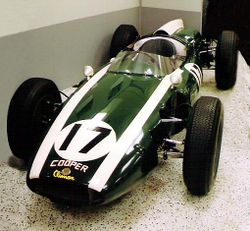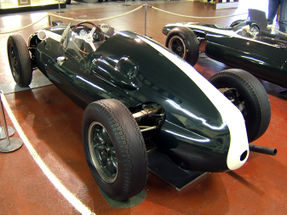Cooper Car Company
 |
|
| Full name | |
|---|---|
| Base | |
| Founder(s) | |
| Noted drivers | |
| Formula One World Championship career | |
| Debut | 1950 Monaco Grand Prix |
| Races competed | 129 |
| Constructors' Championships | 2 (1959, 1960) |
| Drivers' Championships | 2 (1959, 1960) |
| Race victories | 16 |
| Pole positions | 11 |
| Fastest laps | 14 |
| Final race | 1969 Monaco Grand Prix |

The Cooper Car Company was founded in 1946 by Charles Cooper and his son John Cooper. Together with John's boyhood friend, Eric Brandon, they began by building racing cars in Charles' small garage in Surbiton, Surrey, England in 1946. Through the 1950s and early 1960s, they reached auto racing's highest levels as their rear-engined, single-seat cars altered the face of Formula One and the Indianapolis 500, and their Mini Cooper dominated Rally racing. Thanks in part to Cooper's legacy, Britain remains the home of a thriving racing industry, and the Cooper name lives on in the Cooper versions of the Mini (BMW) production cars that are still built in England but are now owned and marketed by BMW.
Contents |
From Shortage, Innovation
The first cars built by the Coopers were single-seater, 500cc Formula racing cars driven by John Cooper and Eric Brandon and powered by a JAP motorcycle engine. Since materials were in short supply immediately after World War II, the prototypes were constructed by joining two old Fiat Topolino front-ends together. According to John Cooper, the stroke of genius that would make the Coopers an automotive legend -- the location of the engine behind the driver -- was merely a practical matter at the time. Because the car was powered by a motorcycle engine, they believed it was more convenient to have the engine in the back, driving a chain.
Called the Cooper 500, this car's success in hillclimbs and on track, including Eric winning the first post war motor race at Gransden Lodge airfield, quickly created demand from other drivers (including, over the years, Stirling Moss, Peter Collins, Jim Russell, Ivor Bueb, Ken Tyrrell and Bernie Ecclestone) and led to the establishment of the Cooper Car Company to build more. The business grew by providing an inexpensive entry to motorsport for seemingly every aspiring young British driver, and the company became the world's first and largest post-war, specialist manufacturer of racing cars for sale to privateers.
Cooper built over 300 500cc Formula Three cars and dominated the category, winning 64 out of 78 major races between 1951 and 1954. This volume of construction was unique and enabled the company to grow into the senior categories; it was with a modified Cooper 500 chassis, a T12 model, that Cooper had its first taste of top-tier racing when Harry Schell qualified for the 1950 Monaco Grand Prix. Though Schell retired in the first lap, this marked the first appearance of a rear-engined racer at a Grand Prix event since the end of WWII.
The front-engined, Formula Two Cooper Bristol model was introduced in 1952. Various iterations of this design were driven by a number of legendary drivers - among them Juan Manuel Fangio and Mike Hawthorn - and furthered the company's growing reputation by appearing in Grand Prix races, which at the time were run to F2 regulations. It wasn't until the company began building rear-engined sports cars in 1955 that they really became aware of the benefits of having the engine behind the driver. Based on the 500cc cars and powered by a modified Coventry Climax fire-pump engine, these cars were called "Bobtails." With the center of gravity closer to the middle of the car, they found that it was less liable to spin out and much more effective at putting the power down to the road, so they decided to build a single-seater version and began entering it in Formula 2 races.
Rear-Engined Revolution


Jack Brabham raised some eyebrows when he took sixth place at the 1957 Monaco Grand Prix in a rear-engined Formula 2 Cooper. But when Stirling Moss won the 1958 Argentine Grand Prix in Rob Walker's privately-entered Cooper and Maurice Trintignant duplicated the feat in the next race at Monaco, the racing world was stunned and a rear-engined revolution had begun. The next year, 1959, Brabham and the factory Cooper team became the first to win the Formula One World Championship in a rear-engined car. Both team and driver repeated the feat in 1960, and every World Champion since has been sitting in front of his engine.
Brabham took one of the Championship-winning Cooper T53 "Lowline" to Indianapolis Motor Speedway for a test in 1960, then entered the famous 500-mile race in a larger, longer and offset car based on the 1960 F1 design. Arriving at the Speedway May 5, 1961, the "funny" little car from Europe was mocked by the other teams, but it ran as high as third and finished ninth. It took a few years, but the Indianapolis establishment gradually realized the writing was on the wall and the days of their front-engined roadsters were numbered. Beginning with Jim Clark, who drove a rear-engined Lotus in 1965, every winner of the Indianapolis 500 has had the engine in the back. The revolution begun by the little chain-driven Cooper 500 was complete.
Once every Formula car manufacturer began building rear-engined racers, the practicality and intelligent construction of Cooper's single-seaters was overtaken by more sophisticated technology from Lola, Lotus, BRM and Ferrari. The Cooper team's decline was accelerated when John Cooper was seriously injured in a road accident in 1963 driving a twin engined Mini and Charles Cooper died in 1964.
After the death of his father, John Cooper sold the Cooper Formula One team to the Chipstead Motor Group in April, 1965. Their final Formula One victory was achieved by Mexican driver Pedro Rodríguez at the 1967 South African Grand Prix in a Cooper T81. In all, Coopers participated in 129 Formula One World Championship events in nine years, winning 16 races.
Besides Formula One cars, Cooper offered a series of Formula Junior cars. These were the T52, T56, T59 and T67 models. Ken Tyrrell ran a very successful team with John Love and Tony Maggs as his drivers. Following the demise of Formula Junior, Ken Tyrrell tested Jackie Stewart in a Formula Three car, a Cooper T72. This test at the Goodwood Circuit marked the start of partnership which dominated motorsport later on.
In 2008, the Cooper name survives (2008) in the chain of UK BMW dealerships operated by Inchcape plc.
Grand Prix victories
| Year | Country | Track | Driver | Date |
|---|---|---|---|---|
| 1958 | Argentine Grand Prix | Buenos Aires | Stirling Moss | January 19 |
| Monaco Grand Prix | Monte Carlo | Maurice Trintignant | May 18 | |
| 1959 | Monaco Grand Prix | Monte Carlo | Jack Brabham | May 10 |
| British Grand Prix | Aintree | Jack Brabham | July 18 | |
| Portuguese Grand Prix | Monsanto | Stirling Moss | August 23 | |
| Italian Grand Prix | Monza | Stirling Moss | September 13 | |
| United States Grand Prix | Sebring | Bruce McLaren | December 12 | |
| 1960 | Argentine Grand Prix | Buenos Aires | Bruce McLaren | February 7 |
| Dutch Grand Prix | Zandvoort | Jack Brabham | June 6 | |
| Belgian Grand Prix | Spa-Francorchamps | Jack Brabham | June 19 | |
| French Grand Prix | Reims | Jack Brabham | July 3 | |
| British Grand Prix | Silverstone | Jack Brabham | July 16 | |
| Portuguese Grand Prix | Porto | Jack Brabham | August 14 | |
| 1962 | Monaco Grand Prix | Monte Carlo | Bruce McLaren | June 3 |
| 1966 | Mexican Grand Prix | Mexico City | John Surtees | October 23 |
| 1967 | South African Grand Prix | Kyalami | Pedro Rodríguez | January 2 |
Mini Legacy
As the company's fortunes in Formula One declined, however, the John Cooper-conceived Mini Cooper -- introduced in 1961 as a development of the Alec Issigonis-designed British Motor Corporation Mini with a more powerful engine, new brakes and a distinctive paint job -- continued to dominate in saloon car and rally races throughout the 1960s, winning many championships and the 1964, 1965 and 1967 Monte Carlo Rallies.
Several different Cooper-marked versions of the Mini and various Cooper conversion kits have been, and continue to be, marketed by various companies. The current BMW MINI, in production since 2001, has Cooper and Cooper S models and a number of John Cooper Works tuner packages.
Coopers Garage
On 1 April 1968, John Cooper leased the building, 243 Ewell Road [1], to the Metropolitan Police and the local Traffic Division (V Victor) moved in. They would stay there for the next twenty-five years and 'TDV' would become one of the busier police garages. In August 1968, they were supplied with the two Mini Coopers index numbers PYT767F and PYT768F. The centre boss of the steering wheel was replace by a speaker and microphone and a PTT transmitter switch, was added to the steering column. The sight of a six-foot bobby getting into the mini greatly amused the locals. The vehicles were trialled for a number of months, but no orders were placed for other garages.
References
- John Cooper Works
- John Cooper - A Very British Marque, A Very British Man
- John Cooper: The Man Who Beat Italia
- Cooper profile at The 500 Owners Association
- TDV Webs site
- John Cooper (1977). The Grand Prix Carpetbaggers: The Autobiography of John Cooper. Doubleday. ISBN 0-385-03081-9
- Cooper Cars, by Doug Nye, 1983, Osprey Publishing, 2003, Motorbooks International
See also
- GPL Driveable, detailed simulations of Cooper's T81 and T77 F1 cars.
Notes
External links
| Sporting positions | ||
|---|---|---|
| Preceded by Vanwall |
Formula One Constructors' Champion 1959-1960 |
Succeeded by Ferrari |
|
|||||
|
|||||||||||||||||||||
|
|||||||||||||